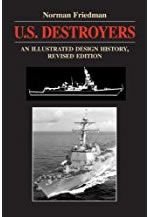USS Sampson (DD-63)
in Hampton Roads,
13 December 1916
|
|
USS Sampson (DD-63) was the name ship of the Sampson class of destroyers, and operated from Queenstown during the First World War, before helping support the first successful transatlantic flight after the war.
The Sampson was named after William Thomas Sampson, a US naval officer during the American Civil War who rose to high rank after the war, serving as Chief of the Bureau of Ordnance from 1893, commander of the battleship USS Iowa from 1897, head of the board that investigated the loss of the battleship Maine and commander on the North Atlantic Station at the start of the Spanish-American War of 1898. He defeated the Spanish fleet at the battle of Santiago (1 June 1898), and ended his career as a rear admiral.
The Sampson was laid down on 21 April 1915, launched on 4 March 1916 and commissioned on 27 June 1916 with Commander B.C. Allen as her first commander. She joined Division 9 of the Atlantic Destroyer Force and had time for her shakedown cruiser and some training before the US entry into the First World War in April 1917. In May she formed part of the escort for a convoy heading from the US to Queenstown via Halifax, and she arrived at her new base in Ireland on 25 May 1917. After an impressively brief pause while two British depth charge projectors were installed on her stern she began combat duties on 29 May. She was used for convoy escort and anti-submarine patrols.
The Sampson rescued two boat loads of survivors from the SS English Monarch on 18 June 1917, and the captain and 30 other survivors from the SS Elele on 18-19 June 1917. Although she wasn't involved in any successful attacks on U-boats, she did take part in a number of attacks on possible targets during her time in the theatre of war.
On 12 December 1918 the Sampson was part of the fleet that welcomed President Woodrow Wilson as he arrived at Brest. She then returned to her base at Queenstown, before departed for the United States on 26 December.
Anyone who served on her between 24 May 1917 and 11 November 1918 qualified for the First World War Victory Medal.
She spent a short period in the New York Navy Yard at the start of 1919, and then joined the 4th Division, 2nd Flotilla of the Destroyer Force. She was based at the Naval Torpedo Station, Newport, Rhode Island. She was then used to help with experimental trials of new torpedoes and mines. In May 1919 she was selected as one of a series of rescue ships that lined the route of the first successful transatlantic flight, made by a flight of Navy NC aircraft.
Between December 1919 and February 1921 she was prepared for deactivation, and on 15 June 1921 she was decommissioned at Philadelpha. She didn’t take part in the Prohibition Era 'Rum Patrol'. On 17 July 1935 she was selected for scrapping under the terms of the London Naval Treaty, she was struck off on 7 January 1936 and sold for scrap on 8 September 1936.
Displacement (standard) |
1,100t |
Displacement (loaded) |
1,225t |
Top Speed |
29.5kts at 17,500shp (design) |
Engine |
2-shaft Curtis turbines |
Range |
|
Armour - belt |
|
- deck |
|
Length |
315ft 3in |
Width |
29ft 10in |
Armaments |
Four 4in/50 guns |
Crew complement |
99 |
Launched |
4 March 1916 |
Commissioned |
27 June 1916 |
Sold for scrap |
8 September 1936 |
 U.S. Destroyers: An Illustrated Design History, Norman Friedmann .
The standard history of the development of American destroyers, from the earliest torpedo boat destroyers to the post-war fleet, and covering the massive classes of destroyers built for both World Wars. Gives the reader a good understanding of the debates that surrounded each class of destroyer and led to their individual features.
U.S. Destroyers: An Illustrated Design History, Norman Friedmann .
The standard history of the development of American destroyers, from the earliest torpedo boat destroyers to the post-war fleet, and covering the massive classes of destroyers built for both World Wars. Gives the reader a good understanding of the debates that surrounded each class of destroyer and led to their individual features.